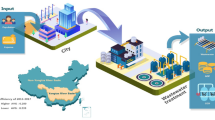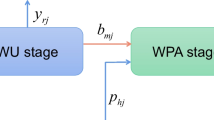Abstract
With the development of China’s economy, pollution has made serious impact on environment and human health. However, environmental protection and residents’ health are becoming more and more important along with the country’s social and economic transformation. Most existing studies have analyzed the path of economic impact on the environment and the production, pollution, and health in isolation. This research takes panel data of 30 provinces in China (including autonomous regions and municipalities, excluding Tibet, Hong Kong, Macau, and Taiwan) spanning 2014 to 2017 as an example, builds an evaluation indicator system on the basis of the three stages of economic production, wastewater treatment, and human health, and uses the undesirable three-stage dynamic data envelopment analysis model to empirically evaluate the total efficiency, stage efficiency, and the efficiency of various indicators. The research results show the average efficiency of the three stages in most provinces in four years is below 0.5, indicating the poor coordination of each stage; the efficiency gaps among the eastern, central, and western regions are very large because of the resource endowments, geographical environment, industrial structure, strategic adjustment, and other infactors. The total efficiency of the three stages of production input, wastewater treatment, and health output in the eastern region are higher than that of the central region and the western region. From the perspective of stage efficiency, most of the 30 provinces exhibit production efficiency < health efficiency < wastewater treatment efficiency. For the three-phase input and output indicators, the efficiency values and development trends of different provinces vary. The efficiencies of input variables in the wastewater treatment stage and health stage are low in most provinces. This means that the provinces should implement accurate policies according to their own evaluation results and improve the relevance and coordination among the three stages through reasonable allocation of medical input and arrangement of urban employment.






Similar content being viewed by others
Data availability
‘Not applicable’.
References
Abbaspour KC, Rouholahnejad E, Vaghefi S, Srinivasan R, Yang H, Klove B (2015) A continental-scale hydrology and water quality model for Europe: calibration and uncertainty of a high-resolution large-scale SWAT model. J Hydrol 524:733–752
Adimalla N, Li P, Qian H (2019) Evaluation of groundwater contamination for fluoride and nitrate in semi-arid region of Nirmal Province, South India: a special emphasis on human health risk assessment (HHRA). Hum Ecol Risk Assess 25(5):1107–1124
Ahmad A, Zhao YH, Shahbaz M (2016) Carbon emissions, energy consumption and economic growth: An aggregate and disaggregate analysis of the Indian economy. Energy Policy 96:131–143
Alabdraba WMS, Hamed HH, Mohammed AE (2020) Performance evaluation of combined O-3/Fenton process on decolorization and COD removal of disperse blue 79 dye from aqueous solution. Desalin Water Treat 173:420–426
Baleta J, Mikulcic H, Klemes JJ, Urbaniec K, Duic N (2019) Integration of energy, water and environmental systems for a sustainable development. J Clean Prod 215:1424–1436
Chan FKS, Griffiths JA, Higgitt D, Xu S, Zhu F, Tang Y, Xu Y, Thorne CR (2018) Sponge City in China-a breakthrough of planning and flood risk management in the urban context. Land Use Policy 76:772–778
Chang C, Wei H, Feng J, Wang Z, Wu X, Wu D, Cheng S, Zhang X, Zhuo R (2009) Temperature and pH double responsive hybrid cross-linked micelles based on P(NIPAAm-co-MPMA)-b-P(DEA): RAFT synthesis and “schizophrenic”. Micellization. Macromolecules 42(13):4838–4844
Chen S, Zhu Y (2004) Subpattern-based principle component analysis. Pattern Recogn 37(5):1081–1083
Chen Y, Cook WD, Li N, Zhu J (2009) Additive efficiency decomposition in two-stage DEA. Eur J Oper Res 196(3):1170–1176
Cheng G, Li X, Zhao W, Xu Z, Feng Q, Xiao S, Xiao L (2014) Integrated study of the water-ecosystem-economy in the Heihe River Basin. Natl Sci Rev 1(3):413–428
Christou A, Aguera A, Bayona JM, Cytryn E, Fotopoulos V, Lambropoulou D, Manaia CM, Michael C, Revitt M, Schroder P, Fatta-Kassinos D (2017) The potential implications of reclaimed wastewater reuse for irrigation on the agricultural environment: the knowns and unknowns of the fate of antibiotics and antibiotic resistant bacteria and resistance genes - a review. Water Res 123:448–467
Cooper WW, Seiford LM, Tone K (2000) Data envelopment analysis, a comprehensive text with models, applications, Second edn. Kluwer Academic published, USA
Fang D, Chen B (2017) Linkage analysis for the water-energy nexus of city. Appl Energy 189:770–779
Färe R, Grosskopf S (1996) Productivity and intermediate products: a frontier approach. Econ Lett 50(1):65–70
Fare R, Grosskopf S, Pasurka CA (2007) Environmental production functions and environmental directional distance functions. Energy 32(7):1055–1066
Farrell MJ (1957) The measurement of productive efficiency. Journal of the Royal Statistical Society: Series A (General) 120(3):253–281
Fu Y, Cui X, Liu L, Zhao J, Leng J, Zhang S (2019) Equilibrium cost of water environmental protection based on watershed sustainability. J Hydrol 579: UNSP 124216
Galli A, Wiedmann T, Ercin E, Knoblauch D, Ewing B, Giljum S (2012) Integrating ecological, carbon and water footprint into a “footprint family” of indicators: definition and role in tracking human pressure on the planet. Ecol Indic 16:100–112
Gong Z, Chen X (2017) Analysis of interval data envelopment efficiency model considering different distribution. Sustainability 9(12):2080
Guo J, Zhu D, Wu X, Yan Y (2017) Study on environment performance evaluation and regional differences of strictly-environmental-monitored cities in China. Sustainability 9(12):2094
Hu J, Wang S (2006) Total-factor energy efficiency of regions in China. Energy Policy 34(17):3206–3217
Kao C (2009) Efficiency decomposition in network data envelopment analysis: a relational model. Eur J Oper Res 192(3):949–962
Kao C, Hwang S (2008) Efficiency decomposition in two-stage data envelopment analysis: An application to non-life insurance companies in Taiwan. Eur J Oper Res 185(1):418–429
Klopp RW, Clifton RJ, Shawki TG (1985) Pressure-shear impact and the dynamic viscoplastic response of metals. Mech Mater 4(3–4):375–385
Kobielska PA, Howarth AJ, Farha OK, Nayak S (2018) Metal-organic frameworks for heavy metal removal from water. Coord Chem Rev 358:92–107
Lacko R, Hajduova Z (2018) Determinants of environmental efficiency of the EU countries using two-step DEA approach. Sustainability 10(10):3525
Li X, Yan X, An Q, Chen K, Shen Z (2016) The coordination between China’s economic growth and environmental emission from the Environmental Kuznets Curve viewpoint. Nat Hazards 83(1):233–252
Li P, Tian R, Xue C, Wu J (2017) Progress, opportunities, and key fields for groundwater quality research under the impacts of human activities in China with a special focus on western China. Environ Sci Pollut Res 24(15):13224–13234
Ma R, Zhang S, Wen T, Gu P, Li L, Zhao G, Niu F, Huang Q, Tang Z, Wang X (2019) A critical review on visible-light-response CeO2-based photocatalysts with enhanced photooxidation of organic pollutants. Catal Today 335:20–30
Park KS, Park K (2009) Measurement of multi period aggregative efficiency. Eur J Oper Res 193(2):567–580
Ren K, Huang S, Huang Q, Wang H, Leng G, Cheng L, Fang W, Li P (2019) A nature-based reservoir optimization model for resolving the conflict in human water demand and riverine ecosystem protection. J Clean Prod 231:406–418
Schroeder P, Anggraeni K, Weber U (2019) The relevance of circular economy practices to the sustainable development goals. J Ind Ecol 23(1):77–95
Shi Z, Wu F, Huang H, Sun X, Zhang L (2019) Comparing economics, environmental pollution and health efficiency in China. Int. J. Environ. Res. Public Health 16(23):4827
Stadler K, Wood R, Bulavskaya T, Sodersten CJ, Simas M, Schmidt S, Usubiaga A, Acosta-Fernandez J, Kuenen J, Bruckner M (2018) EXIOBASE 3: developing a time series of detailed environmentally extended multi-regional input-output tables. J Ind Ecol 22(3):502–515
Tone K (2001) A slacks-based measure of efficiency in data envelopment analysis. Eur J Oper Res 130(3):498–509
Tone K, Tsutsui M (2009) Network DEA: a slacks based measurement approach. Eur J Oper Res 197:243–252
Tone K, Tsutsui M (2010) Dynamic DEA: a slacks-based measure approach. Omega-International Journal of Management Science 38(3–4):145–156
Tone K, Tsutsui M (2014) Dynamic DEA with network structure: a slacks-based measure approach. Omega-International Journal of Management Science 42(1):124–131
Van Gils J, Posthuma L, Cousins IT (2019) The European Collaborative Project SOLUTIONS developed models to provide diagnostic and prognostic capacity and fill data gaps for chemicals of emerging concern. Environ Sci Eur 31(1):72
Wang Q, Li S, Li R (2019) Evaluating water resource sustainability in Beijing, China: combining PSR model and matter-element extension method. J Clean Prod 206:171–179
Wiedmann T, Lenzen M (2018) Environmental and social footprints of international trade. Nat Geosci 11(5):314–321
Wu Y, Zhu Q, Zhu B (2018) Comparisons of decoupling trends of global economic growth and energy consumption between developed and developing countries. Energy Policy 116:30–38
Wu G, Hong J, Li D, Wu Z (2019) Efficiency assessment of pollutants discharged in urban wastewater treatment: evidence from 68 key cities in China. J Clean Prod 233:1437–1450
Xiao J, Wang L, Deng L, Jin Z (2019) Characteristics, sources, water quality and health risk assessment of trace elements in river water and well water in the Chinese Loess Plateau. Sci Total Environ 650:2004–2012
Xing L, Xue M, Hu M (2019) Dynamic simulation and assessment of the coupling coordination degree of the economy-resource-environment system: case of Wuhan City in China. J Environ Manag 230:474–487
Yang Y, Song W, Lin H, Wang W, Du L, Xing W (2018) Antibiotics and antibiotic resistance genes in global lakes: a review and meta-analysis. Environ Int 116:60–73
Zhang Y, Wu J, Xu B (2018) Human health risk assessment of groundwater nitrogen pollution in Jinghui canal irrigation area of the loess region, northwest China. Environ Earth Sci 77(7):273
Zhao Y, Deng X, Lee C, Zhu H (2003) Resettable zero-knowledge in the weak public-key model. Advances in Cryptology-Eurocrypt 2656:123–139
Author information
Authors and Affiliations
Contributions
conceptualization, Z.S. and B.Z.; methodology, Z.S. and H.H; software, H.H and Y-H.C.; validation, Y-H.C, B.Z. and C.S.; formal analysis, Z.S.; investigation, C.S.; data curation, Y-H.C.; writing—original draft preparation, B.Z. and C.S.; writing—review and editing, Z.S. and B.Z.; visualization, H.H; supervision, Z.S. and Y-H.C; project administration, Z.S.;
Corresponding author
Ethics declarations
Ethical approval
Not applicable.
Consent to participate
Not applicable.
Consent to publish
Not applicable.
Conflict of interest
The authors declare that they have no conflict of interest.
Additional information
Responsible Editor: Eyup Dogan
Publisher’s note
Springer Nature remains neutral with regard to jurisdictional claims in published maps and institutional affiliations.
Rights and permissions
About this article
Cite this article
Shi, Z., Huang, H., Chiu, Yh. et al. Linkage analysis of water resources, wastewater pollution, and health for regional sustainable development—using undesirable three-stage dynamic data envelopment analysis. Environ Sci Pollut Res 28, 19325–19350 (2021). https://doi.org/10.1007/s11356-020-12067-2
Received:
Accepted:
Published:
Issue Date:
DOI: https://doi.org/10.1007/s11356-020-12067-2




